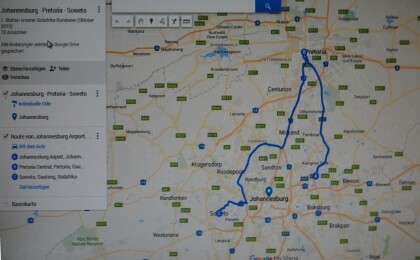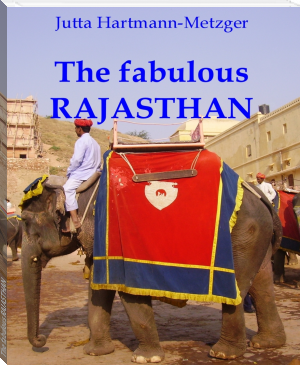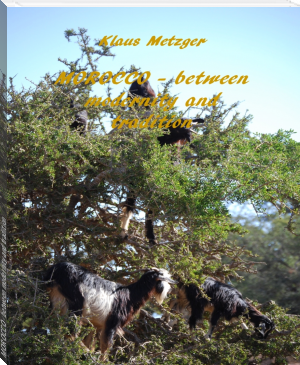South Africa - Land of the Opposites, Klaus Metzger, Jutta Hartmann-Metzger [if you give a mouse a cookie read aloud txt] 📗

- Author: Klaus Metzger, Jutta Hartmann-Metzger
Book online «South Africa - Land of the Opposites, Klaus Metzger, Jutta Hartmann-Metzger [if you give a mouse a cookie read aloud txt] 📗». Author Klaus Metzger, Jutta Hartmann-Metzger
After the Nile Cruise in Egypt (2003/2004), the Kenya Safari (2009) and the Adventures of Morocco (2012), we wanted to visit another country of the great African continent in October 2015: SOUTH AFRICA. The night flight from Frankfurt to Johannesburg lasted 10.5 hours and was with the excellent service of the SAA pleasant to bear.
Why is the wider area of Johannesburg the heart of South Africa? There are more beautiful South African cities, such as Durban or Cape Town. It is the special history that the Boers (who were mostly from Dutch as well as German and French-speaking settlers) had to fight against the British in more than 200 years.
In 1652 the first settlers from Europe came to the Cape of Good Hope at the southern tip of South Africa. Their peaceful situation changed with the arrival of the English, who from 1795 temporarily occupied the Cape during the Napoleonic wars. Afterwards the property changed several times and in 1814 the Netherlands finally abandoned the colony to Great Britain.
The Burs protested against the British administration, which forbid slavery in 1833. This did not agree with the old settlers. Since they could no longer farm their huge farmland without slaves, 6,000 Boers left the Cape and headed north (he went as a "Great Treck" into the history). It was also the British oversight which most of the Boers did not manage.
The path of the "Voortrekkers" led through enemy land, and there was constant conflict with the native inhabitants. After the decisive victory over the Zulu on the "Blood River" the conquerors founded the Burenrepublik Natalia on 16 December 1838, the Oranje-Freistaat 1842. After that the Burenrepubliken Winburg-Potchefstroom, Zoutpansberg, Utrecht and Lydenburg were established until 1844 (a short stop on the bus ride to the Kruger National Park).
Under President Marthinus Pretorius, these four republics joined together with the capital, Pretoria, to the South African Republic, also known as Transvaal, until 1860. In the Constitution, the first laws of racial separation were laid down. In 1877 the British occupied Transvaal. In 1880/81, the Burenaufstand, which is also called the First Burial War, came into being. He ended in 1881 with the peace of Pretoria and the independence of the South African Republic, but the British were given a voice in foreign policy.
From 1883 to 1902 Paul was "Ohm" Kruger President Transvaals. He had German roots and founded the Kruger National Park to protect the wild animals from extinction. In the British Cape Colony, his opponent Cecil Rhodes ruled from 1890 to 1896 as Prime Minister. He prepared the conquest of the Boer States in the Second Burial War (1899 to 1902). This shameful personality, who died at the age of 48 in 1902, will be encountered several times during our journey.
Monument Ohm Kruger in front of KRUGER National Park
The Second Burial War of Great Britain against the South African Republic and the Orange Free State came between 1899 and 1902. After the initial succession of the Boerish army, the Boers lost the war against the militarily superior British.
Their recklessness (among other things with the internment of the family members of the Boers in concentration camps) forced the Boers to the task. In the peace of Vereeniging / Transvaal (1902) the Boerish republics lost their independence. The use of Dutch was allowed in schools and before courts.
In 1907 Great Britain acknowledged the self-government of former Buren republics, and in 1910 the Cape Colony, Natal, Transvaal, and the Orange Free State formed the South African Union as a Dominion in the British Empire: only whites and some wealthy non-whites were eligible. In 1925 Afrikaans became the second official official language in the South African Union. introduced.
The later English Prime Minister, Winston Churchill, was a war correspondent for the Morning Post in South Africa during the Second Burial War. The Boers led a guerrilla war, and they also derailed British military troops. One of these features was a civilian: Winston Churchill. He was taken to prison in Pretoria. He managed to escape over 500 km to Mozambique. On the way he hid himself in a mine. He drove back to Great Britain with the ship. These connections are described in detail in the interesting book ("Death at the Cape" by Martin Bossenbroek).
The reason for the interest of the British in the Boezian provinces Transvaal and Oranje-Freistaat were the valuable mineral resources. Around 1880 gold was found in the eastern areas of the then Transvaal around Barberton and Pilgrim's rest (we drove past our road to the Kruger National Park). In 1886, gold-diggers discovered further deposits on the Witwatersrand (west of Pretoria), which eventually proved to be part of the largest gold deposit in the world.
Cecil Rhodes (since 1890 premier of the British Cape Colony) promoted the conquest of the Burenrepubliken Oranje-Freistaat and the Transvaal. To this end, he incited an uprising in 1895 to the British immigrants in Transvaal, which had hitherto been denied the right to vote. On the British side, the rebellion was to be supported by a 600-strong force led by Rhodes-confidant Jameson.
Monument Cecil Rhodes at the Company's Garden (Cape Town)
However, the president of Transvaal, Ohm Kruger, succeeded in crushing the uprising and forcing the invaders to task. The rebels were captured and partly killed. The German Kaiser, Wilhelm II Kruger, congratulated Kruger with the "Kruger-Depesche", which had entered the history, to his success. It was only during the Second Burial War that the British succeeded in conquering the provinces Transvaal and Oranje-Freistaat (as I have already described).
Due to the precious mineral resources still found today in the Transvaal (now Gauteng), this region can still be described as the heart of South Africa. The development of the South African city of Johannesburg - located in the center of this province - can be seen very well. The town was founded as a small gold digger settlement and tent town on 4 October 1886. With the discovery of gold, thousands of workers and fortune-hunters from the United Kingdom, the Cape Colony and other countries migrated into the Boerian territories and settled in Johannesburg.
Within ten years the city grew to more than 100,000 inhabitants. The economic value of this landmark rose rapidly, which led to tensions between the Boers, who had dominion over the region during the 19th century, and the British, which culminated in the Second Burial War between 1899 and 1902.
The Boers lost the war and also control over the South African Republic to the British. These paved the way for organized mining.
In 1948, the South African government introduced a strict racial system, apartheid. The immigration of blacks and Indians has been strictly regulated. The black and colored population was forced to move into areas separated by races, which had previously been arbitrarily determined by the white government. This gave rise to huge barrack settlements, the so-called Townships around Johannesburg, of which Soweto (C) (short for: South Western Townships) is the best known. Nelson Mandela lived here for many years; His home in Orlando is nowadays a tourist attraction. (Nelson Mandela House) In addition, the non-white population was forbidden to take qualified work, and many blacks, such as Basutoland (today Lesotho), had to work as migrant workers in Johannesburg's goldmines.
Painted fireplaces in Soweto
After this historical background information, it was exciting to get a picture of the situation in the "heart of South Africa" as an interested tourist. We therefore went without a break from Johannesburg airport (A), where we arrived at 7:30 am (after a relaxed night flight), by bus to Pretoria (B) (distance about 65 km). It was spring time, which could be seen in the numerous, flowering Jacaranda-trees in front of the town hall and other places in the city.
Jacaranda trees in front of Union Building
Another stop of our tour was the Union Buildings, which is situated on a hill, and serves as a government seat during the period from July to December (the rest of the days are held by the deputies in Cape Town). The complex was built between 1910 and 1913 and has a length of more than 275 m. In 1994 Nelson Mandela was sworn in as the first black president of the Republic of South Africa.

Before the Union Building, the great statue of Nelson Mandela surprised us. The worship of the first president of the Republic of South Africa (without apartheid), who died on December 5, 2013 at the age of 95, is still omnipresent throughout the country. This is the 9m high statue, which cost 560,000 euros and was inaugurated on 16 December 2013 (the day of atonement). They outstretched arms of the Nelson Mandela statue are to be a call to the South African people to unite to the "Rainbow Nation".
Nelson Mandela Statue in Pretoria
After I learned about the great poverty in the townships on the round trip through South Africa, I learned about the high unemployment among the colored people and we were always warned by the tour guide before the criminals in Durban and Cape Town (especially at night), I wondered what Nelson Mandela for the people of South Africa? Exactly quite little! He lived from the nimbus of his 27-year imprisonment as a prisoner of the South African government. After his release in 1990, he celebrated his worldwide travels. Finally, he was awarded the Nobel Peace Prize in 1993.
US President Barack Obama got it in 2009. But have they really earned themselves the peace in the world? After my return to Germany, "Nelson Mandela" continued to interest me (as I wanted to write about it). And I now also found some critical considerations that strengthened my impression. I found the article by Andreas Müller "The dark side of Nelson Mandela" in the Feuerbringer magazine. Somehow, for me, the worship of Nelson Mandela has been a bit of a repression, for originally he was an ANC terrorist who was sentenced to death in the Rivonia trial (October 63 to June 64) in Pretoria.
Only his urgent speech, which concerned the armed struggle for equal treatment and the repressive laws, saved his life and his fellow-prisoners. On June 12, 1964, the remaining eight defendants were sentenced to life imprisonment.
2. From Johannesburg to the Kruger National Park in South Africa
After 30 hours travel time (including visits and lunch in Pretoria, as well as the short stop in Soweto), we were glad that we were able to check in at the Misty Hills Country Hotel in Muldersdrift (between Johannesburg and Pretoria). We searched our African bungalow in the larger garden. When we went to the excellent restaurant Carnivore





Comments (0)